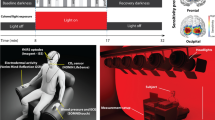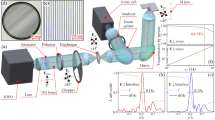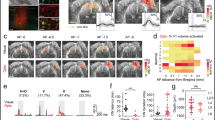Abstract
Application of optical methods to human brain tissue in vivo, e.g., measuring oxyhemoglobin and deoxyhemoglobin concentration changes with near-infrared spectroscopy (NIRS), requires the a priori assumption that background optical properties remain unchanged during measurements1,2. However, fundamental knowledge about light scattering by brain cells per se remains sparse; many factors influence light transmission changes through living brain tissue, bringing into question what is being measured. We have observed slow wave-ring spreads of light transmission changes on the rat cerebral cortex during potassium-induced cortical spreading depression (CSD) and ascribed them to squeezing-out of blood from capillaries by swollen brain cells3,4. However, in rat hippocampal slices, where no blood components were involved, similar light transmission changes were observed during K+-induced CSD and ascribed to cell swelling and dendritic beading5,6,7. Here we show that two-dimensional light scattering changes occur through suspensions of osmotically swollen (depolarized) red blood cells, apparently arising from light scattering changes at the less curved, swollen surface of the steep electrochemical gradient coupled with water activity difference across the plasmic membrane. These optical property changes are likely to be relevant to interpretation of photometry or spectroscopy findings of brain tissue in vivo, where neurons are polarizing and depolarizing during brain function.
Similar content being viewed by others
Article PDF
Author information
Authors and Affiliations
Corresponding author
Rights and permissions
About this article
Cite this article
Tomita, M., Suzuki, N., Tomita, Y. et al. Depolarization increases cellular light transmission. Nat Prec (2008). https://doi.org/10.1038/npre.2008.2001.1
Received:
Accepted:
Published:
DOI: https://doi.org/10.1038/npre.2008.2001.1



